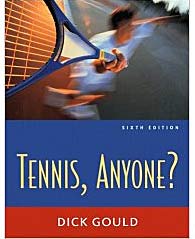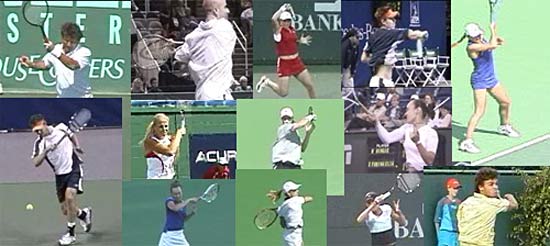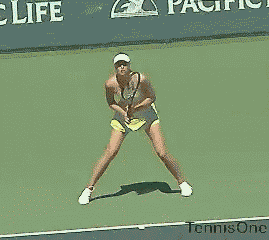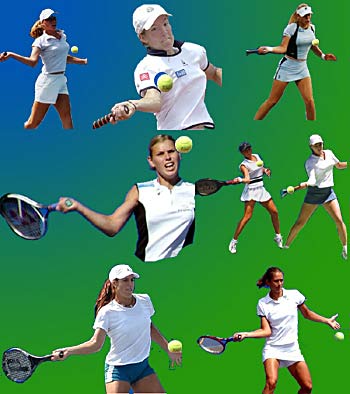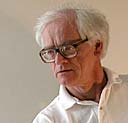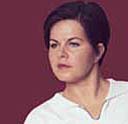|
TennisOne Lessons Improving Player Instruction By Ray and Becky Brown Tennis instruction has made very little progress since 1948 when the seminal book, The Tom Stow Tennis Teacher and Stroke Developer was published. Stow's book was significant when first published in that it provided a disciplined approach to training instructors and subsequently influenced many instructors that followed. Further, many of the ideas set forth by Stow are significant today. However, science has made major advances in technology and learning theory since Stow's seminal work; but tennis instruction has not kept pace with these advances. The consequence of this is that the difference between professional skills and the skills of the general public has widened to the point that the general public can no longer relate to the skill of players they see on TV.
An example of the fact that Stow's ideas have had a significant influence can be seen in a quote from Dick Gould who states in his classic book Tennis Anyone that "...your chance of hitting the ball well is enhanced if the start and finish are right." This single statement by Stow launched a teaching culture that is still with us today and is an example of how great pioneers such as Stow, if taken as gospel, can at once advance and restrict the future of their discipline.
As recently as two years ago, the great Robert Lansdorp repeated these very words in a TenninONE article. There can be no doubt that a pioneer as distinguished as Stow never intended to write a "tennis gospel" which would shackle all future instruction. As all good researchers, Stow surely expected that those who followed in his footsteps in the teaching profession would continue to advance the state of formal tennis instruction initiated by his work rather than stop in their tracks, effectively proclaiming that everything that was needed was known about how to teach tennis. For example, Jack Groppel states in his High Tech Tennis" that as you hit the ball, practice a long follow-through after impact." This unscientific culture has single handily done more to restrict the progress of tennis instruction than any other practice. The reason that this culture is an institutionalized roadblock to progress is explained by appealing to three of the key specifications required by any system of instruction:
The the stroke boundary condition and the culture of the follow through violates the last two of these three specifications in being contradictory and being scientifically incorrect. Lets take a closer look at the boundary condition. As to the scientific correctness of Stow's statement, the simple answer is that what happens between the start of a stroke and the finish of a stroke is so complex that there is virtually no chance that it will "...usually take care of itself." As an example, note that the grip a player uses has a profound impact on what happens between the start and finish of their stroke. Not only are the intermediate mechanics dependent on the grip, they are also dependent on the speed of the stroke, the foot position at the moment the racquet begins to advance, whether the player is in position, the stance, and so on. Further, today, the forehand has over a dozen "follow-through's," hence there are at least a dozen stroke boundary conditions.
If Stow's statement were to be implemented carefully, it would require teaching at least a dozen boundary conditions to cover as many cases as possible. While the variability of the boundary conditions provides a serious limitation on classifying them for the purposes of instruction, worse still is the variability of the human biomechanics of the forehand. The inherent variability in the movement of the limbs, especially the shoulder joint, makes it impossible to assure clean and forceful contact by relying on boundary conditions. For example, the speed of the stroke must vary greatly between the boundary conditions and this speed can affect the stability of the movement causing the racquet face to tilt downward enough to send the ball into the net. No boundary condition can account for this. As a last point we recommend conducting the following experiment. Get a student to make good contact with the ball by emphasizing ball contact. After a short period of time you should see improvements emerging. Now have the same student focus on the follow-through. What you will usually see is a total breakdown in the contact. The reason is that the human brain cannot focus on good contact and on a good follow-through simultaneously and at the speed of a even a slow tennis stroke, these thoughts are nearly, in a relative sense, simultaneous.
One might point to Lansdorp's many successes as proof that teaching the Stow stroke boundary condition "works." This is a serious mistake. No single concept in a teaching method can account for success. If we single out the boundary condition for examination then we should look at all of Lansdorp's students over his entire teaching career (with whom he has made the boundary condition a central theme) and divide the number of professional successes by the total number of students to get a "probability" that the boundary condition promotes rapid stroke development. But even this is insufficient. An easy counter argument to the boundary condition is to note that Lansdorp is a great disciplinarian and discipline, after self confidence, is more important than any other concept of instruction.
This points to a second significant problem that has restricted instruction and student achievement. Humans think they can teach a stroke even if they cannot execute it. This is a mistake as noted by the quote from Stow above. Imagine trying to learn calculus from someone who does not know the subject. It is a fact that one cannot effectively teach more than they can do. However, in special cases in which the student comes with a good base of knowledge, an instructor might provide a clue for the student that will cause their knowledge to fall in place. In these cases, the instructor has not taught anything, but has functioned as a facilitator with the student doing all the work. It is not uncommon for instructors to take credit for a student's progress under these circumstances This error in judgement does not result from their ego needs, but comes from a misreading their own contribution to the student's progress.
To elaborate on Stow's implied thesis, let us take a closer look at why one cannot teach what one cannot do. To set the stage consider this: Is it possible for someone who does not know calculus to teach you calculus? Obviously not! The reason is that the teaching process has several stages. One is the ability to formulate in clear unambiguous language the information to be conveyed. To do this one must have a clear concept of that information. As one cannot invent information, it must be gained from experience and from deductions from experience through a conscious process. As noted above, we do not have such conscious access to our actions. So how do we get our knowledge. Through a trial-and-error process. When we carry out an action, we do have a fleeting memory of a fragment of the action which will last a very short period of time. During this time, if we reflect on this fragmentary memory, we can form a conscious memory of that fragment. If we do a similar action many times, it is possible to acquire a complete set of fragments that we can string together, after some pain staking analysis, to from a complete picture of what we are doing. If we then write this down (memory is very faulty) we are in a position to convey it to someone else. Thus we see from this discussion just how hard it is to be a good instructor. Students who come with a broad base of knowledge in place that they have not acquired from an instructor are often favored over those that do not because they are easier to "teach." But this is not teaching, it is facilitating their development by providing them with clues, some of which are random. Most people do not come with inherent knowledge, so the instructor must be able to teach the average person who comes to them. In any case, if the instructor cannot set an example, the burden of learning is placed unduly on the shoulders of the student. Another component of the learning process requires that the student do exercises, just as in any other class, in order to fill in the blanks and develop an intuitive understanding of the ideas being presented by the instructor. The exercises (which should not be thought of as repetitions but rather as experiments) must continue interactively with feedback from the instructor. As Stow notes, they must start out as simple as possible at first: "By using this mechanism [Stow's stroke developer], it is now possible to practice strokes and footwork with a stationary ball. This is extremely important as It allows the pupil to practice a given stroke over and over until it is mastered without worrying about the timing the ball." However, the instructor must be careful not to fall into the trap of micro-managing the student. The student needs freedom to experiment and if this freedom is constantly blocked by the instructor, the student's progress will stall. Stow's emphasis on simplification was not extended by subsequent researchers but rather has been accepted for years without significant modification. Our stroke research starting around 2002, nearly 50 years after Stow's work, has finally advanced Stow's intuition significantly to every part of the stroke. Thinking uncritically is common in tennis, and is therefore a common problem Another area which has not kept pace with science is the concept of teaching by "feel." There are many examples that can be found among instructors that rely on feel. Stow was a proponent of teaching the "feel" of the stroke. Stow's emphasis on feel was not misplaced; however, advances in neuroscience allows us to do far more with this concept and to avoid its pitfalls, than was possible at Stow's time. What Stow could not know was that when first learning professional technique (as opposed to amateur technique), most people will not be able to feel anything sufficiently distinct to reproduce the components of a professional stroke from feel.
A problem with this approach is that when a student cannot feel the stroke component, they assume that they will never feel it and just give up. Feeling is a feedback process connected with some, but not all, physical actions. This feedback process helps guide the learning process in many cases. However, the human brain does not start out having a distinct feeling corresponding to many complex motions common to tennis. For example, upper arm rotation has virtually no feeling at all for most humans, but it is essential to some versions of the power forehand such as Roddick's. Elbow positioning for a power forehand has the opposite problem in that it feels awkward to most people and they thus abandon it. So the feeling approach must be supplemented with an understanding of the feeling feedback loop. In particular, the student must be counseled that they may not initially feel anything, but that by doing exercises, feeling will usually develop corresponding to an action. But the feeling approach, even when combined with the boundary condition thesis makes it very difficult to explain how professionals produce so much power at contact. The answer is that humans have two distinct motor systems. A nominal system and a ballistic system (a method of rapid acceleration referred to as a "spring" by Doug King). Keep in mind that they are very different modes of action. Some people are born with a sensory perception, or feeling, of the ballistic system, but most are not. A powerful professional stroke requires the use of the ballistic system, but if you teach based on the feel thesis without knowing this, your students may never learn this critical form of acceleration. Clearly, the feeling thesis is not wrong, it is just scientifically incomplete and provides another example of how tennis has not kept pace with science even though Stow gave us a good direction to go in.
Another example of where tennis has not kept pace with science is provided by an analysis of the elbow position (mentioned earlier) before racquet head acceleration. Because the shoulder is so unstable, elbow position is a critical element in high-speed stroke production. However, this subtle element lies between the start and finish and cannot be easily seen by the naked eye. Recall that the human eye has difficulty resolving 6 frames per second accurately. One consequence of this that instructors cannot see the elbow position at contact, regardless of how "perfect" the start and finish may be. Also, as stated above, students cannot feel this position easily. However, using standard video or even still photography, the subtitles of elbow position can be easily resolved.
In addition to the feet and elbow, another key source of instability is the control of the upper body during the stroke. Since the upper and lower parts of the body are supported by the fragile spinal column, the possibilities for unstable motions to develop from the force of a high speed stroke are enormous. This cannot be observed and can be the source of copious unforced errors. Also, if the instructor is not able to hit at high speeds themselves (that is, demonstrate consistent high speed strokes), they will never know how important conditioning the core muscles is to control the upper and lower parts of the body during a high speed rally. In the video below, following Stow's admonitions, we demonstrate an exercise to develop core strength for high speed rallies.
The exercises illustrated in the video on the right are superior to core training using a medicine ball in that it consists in hitting 50 forehands at high speeds, as seen by the radar, as fast as you are able. A medicine ball cannot be thrown at these speeds. We do 200 reps of this exercise every few days. The radar provides immediate feedback about your progress and is an eye-opening experience in that you will find that hitting at high speeds requires a very high level of core strength. Consistent with Stow's teachings, it is a fact that as an instructor, until you are able to hit forehands and backhands from a dropped ball at over 75mph you will be very limited in explaining to your students how this is done. Also if you can't do this, why should your students believe it can be done, or that what you tell them will work. Only the Tennis Industry has the Economic Power to Improve Instruction There have been numerous individual efforts to organize tennis instruction. The work of Braden, Groppel, Van der Meer, Gould, Stow, Brody, the USPTA, PTR, USTA, and others are significant in this effort. However, all trade organizations and individuals so far have been unable to produce a text that would meet the high academic standards such as are necessary for a quality college course. The efforts of these individuals and trade organizations demonstrate how hard the problem of writing a text on tennis really is. Integral to this problem is the fact that tennis has not kept pace with other sports in the utilization of science and technology. The next question is "WHY not?" The answer is economics. For example, football is a multi- billion dollar industry. With so much money at stake, football has pushed the limits of technology. Winning the super bowl has brought technology into play at every turn to gain a competitive edge. On the other hand, the economics of tennis are driven by the tennis industry which stands to gain the most from a vibrant tennis market. Unlike football and other team sports, tennis does not have franchises capable of putting money into significant research and analysis. No individual is financially strong enough to do this and none of the current teaching organizations, including the USTA, are financially strong enough to do this. In short only the tennis industry is capable of providing the leadership and financing needed to bring tennis instruction to a level comparable with other top sports. From our experience in developing complex multi-hundred million dollar defense systems, it is clear that developing a well disciplined curriculum for educating tennis professionals and students in a manner comparable to electrical engineers requires the type of results-oriented focus that is common to managers that have to compete in the market place. While an educational institution must ultimately be able to operate without product biases, its establishment must have firm management discipline guided, not by traditional tennis dogma, but science and technology. Summary It is clear that the current state of Instruction for Instructors is overly reliant on outdated teaching techniques, unproven teaching methods, uncritical approaches to teaching, and a lack of understanding of technology. Also many potential tennis players from the ranks of the general public try tennis once and walk away because they do not relate to the unscientific approach to instruction. The best solution is for the tennis industry to take tennis education into their own hands. They have the means and the motivation. Better, more scientifically guided instruction means more players and thus more sales. Attempts in the past have failed because the qualifications for changing the teaching professional were not fully understood. Domain experience is not enough. Change-management leadership must also understand technology and be skilled at project management based on cost, schedule and technical performance. With a technologically well founded approach, the public will better play better and better relate to current professionals, develop their own skills faster and have a renewed demand for tennis products. Your comments are welcome. Let us know what you think about Ray and Becky Brown's article by emailing us here at TennisONE. Ray and Becky Brown are the founders of EASI TennisTM. The EASI TennisTM System is a new and revolutionary method of teaching stroke technique that can dramatically reduce the time needed to learn to play master, or any level, of tennis. To learn more about the EASI TennisTM System, click here. |

